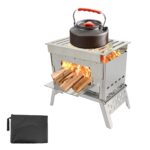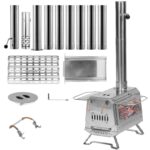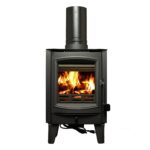
Introduction to Wood Burning Camping Stoves
Wood burning camping stoves have emerged as a popular choice for outdoor enthusiasts seeking an efficient and sustainable cooking solution. These stoves utilize readily available natural resources, making them appealing for campers and backpackers aiming to minimize their ecological footprint. Unlike traditional gas or propane stoves, wood burning stoves rely on small twigs, branches, and other organic materials, providing a renewable energy source. This eco-friendliness not only reduces reliance on fossil fuels but also minimizes waste produced during outdoor cooking activities.
One of the main advantages of wood burning camping stoves is their practicality in various environments. Campers can often find dry wood or biomass nearby, eliminating the need to carry heavy fuel canisters, which can take up valuable pack space and add weight to a backpack. This characteristic makes them particularly advantageous for long hikes or extended trips where every ounce counts. Additionally, these stoves can function in remote locations where access to commercial fuel sources may be limited.
Wood burning stoves also offer versatility in cooking techniques, allowing users to grill, boil, or simmer meals effectively. By regulating airflow and wood placement, users can achieve different cooking temperatures to suit their culinary needs. This adaptability enables outdoor chefs to experiment with various dishes, enhancing their overall dining experience in nature. Furthermore, the soothing sound and warmth generated by the open flame contribute to the ambiance of outdoor camping, making wood burning stoves not only practical but also enjoyable.
In summary, wood burning camping stoves stand out as an exemplary choice for those who value sustainability, efficiency, and versatility in their outdoor cooking endeavors. By embracing this innovative approach, campers and backpackers can benefit from a reliable cooking solution while fostering an eco-conscious attitude towards nature preservation.
Benefits of Using Small Wood Burning Stoves
Small wood burning camping stoves have gained popularity among outdoor enthusiasts due to their numerous benefits. One of the primary advantages is their lightweight design, which makes them incredibly easy to transport. These stoves are often made from durable materials that can withstand the rigors of outdoor use, yet they are compact enough to fit into a backpack without adding significant weight. This feature is particularly appealing for backpackers and hikers who need to limit their load while still ensuring they have a reliable cooking solution.
Another significant benefit of using small wood burning stoves is their cost-effectiveness. Unlike traditional fuel options, which may require purchasing canisters or liquid fuel that can be costly over time, wood is often readily available in many camping locations. This ability to utilize small, fallen branches and twigs not only reduces the need for specialized fuel products but also minimizes the overall cost of outdoor cooking. Consequently, campers can enjoy preparing warm meals without the burden of excessive expenses.
Furthermore, small wood burning stoves are an environmentally friendly option, as they harness renewable fuel sources. By utilizing wood, these stoves contribute to reducing waste by encouraging users to make use of natural materials found in the environment. This practice not only lessens the carbon footprint associated with traditional fuels but can also enhance the outdoor experience by connecting users with nature. The use of small wood burning stoves promotes sustainability, aligning with the values of many who are concerned about their ecological impact while enjoying the great outdoors.
In conclusion, the benefits of small wood burning camping stoves—including their lightweight design, cost-effectiveness, and environmental advantages—make them a practical choice for outdoor cooking. Whether embarking on a long hiking journey or enjoying a short camping trip, these stoves offer a reliable and convenient solution for meal preparation.
How to Choose the Right Small Wood Burning Stove
When selecting the ideal small wood burning stove for camping, several factors must be considered to ensure it effectively complements your outdoor experience. First and foremost, the size of the stove is crucial. It should be compact enough to fit into your camping gear without adding significant weight or bulk. A lightweight design is preferred, particularly for backpackers who need to minimize carry weight without sacrificing performance.
Next, evaluate the materials used in the stove’s construction. Stoves made of stainless steel or aluminum offer durability while remaining lightweight. On the other hand, models incorporating cast iron may provide superior heat retention but can be heavier. Assess your camping habits; if you frequently move between different locations, a lighter, more portable stove may be beneficial.
Heat output is another critical aspect to consider. Look for stoves that provide adequate heat for your cooking needs, taking into account the amount of food you typically prepare. If you anticipate cooking for a larger group or in colder weather conditions, a stove with a higher heat output may be necessary.
Ease of use is paramount when it comes to wood burning camping stoves. Ensure that the stove you choose has an intuitive setup process and is designed with user-friendly features such as adjustable air vents for controlling burn rates. Furthermore, consider models that allow for easy access to the combustion chamber for refueling and cleaning.
Lastly, take into account your specific camping needs and preferences. If you enjoy quick weekend trips, a small and straightforward stove may suffice. Conversely, avid campers who prioritize gourmet cooking may benefit from a larger, more versatile model. Ultimately, your choice should align with your outdoor activities and personal cooking style.
Setting Up Your Wood Burning Stove
Setting up a small wood burning camping stove requires careful consideration to ensure safety and efficiency. The first step is to select a suitable location. Choose a flat, stable surface that is away from flammable materials such as dry grass, leaves, or branches. Ideally, the site should be sheltered from strong winds to avoid unpredictable flames that could endanger both you and the environment. Look for an area that allows proper ventilation, as this is critical for ensuring that smoke dissipates effectively and does not accumulate in your cooking space.
Once you have selected your location, it is essential to prioritize safety. Check the regulations of the camping area, as certain locations may have restrictions on open flames or wood burning stoves. Always maintain a safe distance from your tent and communal spaces, ideally placing the stove at least 10 feet away from these areas. Additionally, having a fire extinguisher or a bucket of water nearby is recommended in case of emergencies. Ensure that the area is cleared of debris to prevent any accidental ignitions.
After ensuring a safe spot, the next step is to prepare the stove for use. First, assemble the stove according to the manufacturer’s instructions, taking care to secure all components tightly. If the stove features a chimney or stovepipe, ensure it is properly installed to direct smoke away from your cooking space. Once assembled, gather dry, seasoned wood for fuel, as green or damp wood can produce excessive smoke and sparks, making the cooking process less efficient. Light your stove following the manufacturer’s guidance, and enjoy the warmth and comfort it provides while enhancing your outdoor cooking experience.
Fire Safety Tips for Using Wood Burning Stoves
When utilizing wood burning stoves during camping, fire safety must be a priority to ensure a safe and enjoyable experience. One of the fundamental aspects of fire safety is proper fire management. Always consider the location of your stove; it should be positioned on a flat, stable surface away from flammable materials, including leaves, dry grass, and overhanging branches. Additionally, a fire ring or a dedicated fire pad can provide necessary insulation and containment for the stove.
When it comes to materials used for fuel, it is imperative to use only dry, seasoned wood specifically intended for burning. This type of wood burns more efficiently and produces less smoke, reducing potential dangers and enhancing the overall functionality of your wood burning stove. Avoid burning treated wood, plastics, or other debris, as these can release toxic compounds into the air and create hazardous conditions.
Regular monitoring of the fire is crucial. Attending to your wood burning stove and keeping it within manageable limits helps prevent it from getting out of control. It’s essential to understand that winds can change unexpectedly, potentially spreading sparks or embers. Always keep a bucket of water or sand nearby to extinguish any stray sparks or to put out the stove when it is no longer in use.
In terms of extinguishing techniques, allow the fire to burn down to ashes, and carefully douse it with water, ensuring all embers are fully extinguished. Stir the ashes with a stick to ensure no lingering heat remains, and check for residual warmth before leaving the site. Following these essential fire safety tips will not only protect you and your campsite but also contribute to the preservation of the natural environment.
Cooking Techniques with Small Wood Burning Stoves
Cooking with small wood burning stoves offers a unique and rewarding experience, allowing campers to prepare a variety of meals while enjoying the great outdoors. The versatility of these stoves enables different cooking techniques that can elevate your camping culinary skills. A fundamental aspect is understanding the heat control; small wood burning stoves can produce a high amount of heat, making it essential to manage the flames effectively. By adjusting the amount of fuel and the airflow, you can achieve the desired temperature for various cooking methods.
One effective technique is direct cooking, where food is placed directly on a grill grate above the flames. This method is ideal for grilling vegetables, meats, or even toast, yielding a delicious smoky flavor. When roasting or baking, it’s advisable to use a Dutch oven. This heavy, cast-iron cookware retains heat well and distributes it evenly, making it suitable for dishes like stews, casseroles, or even baked goods. You can create a variety of meals by combining ingredients like root vegetables, rice, and proteins, all simmering together for a hearty dish.
Another beneficial technique is foil cooking, which involves wrapping food in aluminum foil and placing it over the fire or in hot coals. This method is perfect for cooking fish, potatoes, or mixed vegetable packets, allowing flavors to meld while keeping the food moist. Additionally, using a stovetop kettle or pot, you can easily boil water for coffee, tea, or instant meals. A key component to successful wood cooking is also choosing the right type of wood; hardwoods like oak and maple burn longer and produce more heat, making them optimal for cooking compared to softer woods.
In conclusion, experimenting with these various cooking techniques on a small wood burning stove can transform your camping experience. With the right techniques, cookware, and understanding of heat management, you can enjoy delicious homemade meals in the heart of nature.
Maintenance and Care for Your Wood Burning Stove
Proper maintenance and care are vital for the longevity and efficiency of your small wood burning camping stove. Regularly attending to your stove not only ensures that it functions effectively but also enhances safety during your camping outings. To maintain your wood burning stove, start by cleaning it after each use. Allow the stove to cool down completely before removing the ashes. Use a metal scoop or brush to clear out the ash from the combustion chamber, and dispose of it in a safe manner. Regular ash removal prevents build-up, which can impede airflow and reduce combustion efficiency.
Next, inspect your stove for any signs of damage. Check for cracks, warps, or rust, particularly in the body and the door of the stove. Pay attention to the seals and gaskets as well, as these components are critical in maintaining proper airflow and heat retention. If you notice any damage, it is important to address it promptly to avoid further deterioration. Minor repairs can often be made with high-temperature sealants or replacement parts, but significant issues may require professional attention or even replacement of the unit.
When you finish using your wood burning stove for the season, store it properly to prevent damage during storage. Ensure it is completely clean and dry before packing it away. Use a breathable storage bag to protect it from dust and moisture. If possible, keep it in a sheltered area that is away from direct sunlight to prevent degradation caused by UV exposure. By following these steps—cleaning, inspecting, and storing properly—you can prolong the lifespan of your small wood burning camping stove, ensuring that it remains a reliable companion on your outdoor adventures.
Sustainability and Environmental Impact
Wood burning camping stoves present a viable alternative to traditional fossil-fuel-based cooking methods, offering significant environmental benefits that contribute to sustainable outdoor practices. One of the primary advantages of these stoves is their utilization of biomass—specifically, wood—as fuel. By relying on wood, campers reduce their dependency on fossil fuels, which are finite resources and major contributors to greenhouse gas emissions. This shift not only supports renewable energy but also encourages a more sustainable outdoor experience.
However, it is crucial to approach the use of wood burning stoves with responsibility and care. The sourcing of wood should prioritize sustainable practices, such as utilizing dead and downed timber, which minimizes ecosystem impact while still providing fuel for cooking. By avoiding the harvest of live trees, users can help preserve forests, allowing them to continue to sequester carbon and provide habitat for wildlife. Campers are also encouraged to understand local regulations regarding wood collection to ensure compliance with environmental protection standards.
Furthermore, the efficient design of modern wood burning stoves plays a significant role in mitigating environmental impacts. Unlike traditional campfires, which can release significant amounts of smoke and particulate matter, these stoves offer improved combustion efficiency. This means more complete burning of the fuel, leading to fewer emissions and a reduced environmental footprint during camping trips. Additionally, wood burning stoves can often be adjusted to control heat output, further optimizing their efficiency.
In conclusion, the environmental impact of utilizing wood burning camping stoves hinges on responsible sourcing and efficient use. By embracing these sustainable practices, users can enjoy the benefits of outdoor cooking while also contributing to the preservation of our natural environment.
Recommended Small Wood Burning Camping Stoves
When selecting a small wood burning camping stove, it is essential to consider not only the stove’s performance but also its design, weight, and ease of use. Several models stand out in the market, impressing outdoor enthusiasts with their innovative features, affordability, and positive customer feedback.
Firstly, the Solo Stove Lite is highly recommended for solo adventurers and minimalists. This stove’s double-wall construction promotes efficient burning, minimizing smoke and maximizing heat output. Weighing just 9 ounces, it is incredibly portable and allows for easy packing. Customers often commend its simplicity and the ease of finding natural fuel sources such as twigs or pine cones, making it an ideal companion for camping trips.
Next on the list is the WoodBurner Portable Camping Stove. This model not only offers a compact design but also features a built-in chimney system that enhances airflow for optimal combustion. With a weight of around 4 pounds, it remains lightweight while ensuring durability. Users have particularly highlighted its versatility; it can be used for cooking or warmth, making it a valuable addition to any camping gear. Its pricing sits comfortably within a reasonable range, appealing to budget-conscious campers.
Additionally, the Campfire Defender Wood Stove stands out for its eco-friendly design and safety features. This stove incorporates a spark screen and adjustable airflow, allowing for better control over the burning process. Weighing approximately 3.5 pounds, it strikes a balance between portability and stability. Customer reviews often praise its performance in various weather conditions, making it a reliable choice for any camping scenario.
In conclusion, selecting the best small wood burning camping stove hinges on individual preferences, such as weight, ease of use, and desired features. The Solo Stove Lite, WoodBurner Portable Camping Stove, and Campfire Defender Wood Stove each present unique benefits, ensuring that campers can find a suitable model to enhance their outdoor cooking and heating experience.





